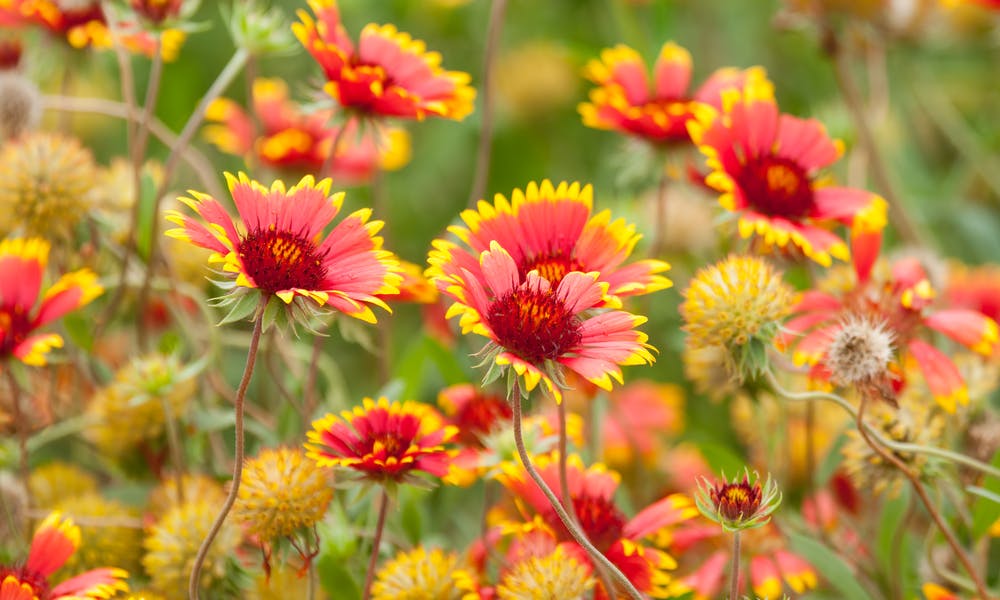MENU
Indian Blanket Flower: Long Living Beautiful Blooms

The Indian blanket flower, sometimes just called the blanket flower or referred to by its scientific name, gaillardia, is an easy to grow perennial that many mistake as a type of daisy. There are more than 20 species of blanket flower, and most of them are native to the US, including the Indian blanket. Most modern blanket flowers we have now are actually hybrids.
Have you been thinking about growing the Indian blanket flower in your own home garden? If so, you are in the right place. Here, you can learn:
- General information about the Indian blanket flower
- How to grow the Indian blanket flower
- Propagating the Indian blanket flower
- Blanket flower varieties
- Pruning the Indian blanket flower
- Pests and diseases
General Information About the Indian Blanket Flower
The blanket flower got its name thanks to the way it grows; it slowly spreads and then blankets an area. The flower can reseed itself and even take over a flower bed. Just keep in mind that because these plants are hybrids, you can find some surprises and variation from self-seeding.
The Indian blanket flower is a perennial, and it can grow up to 18-inches in height and up to two feet wide. This flower requires full sun, and you must plant it in well-draining soil with a pH between 6.1 and 6.5. Don’t plant these in clay soil.
Though these flowers don’t live an extremely long time, they have repeat flowering, so you can get blooms all the way through fall. The Indian blanket flower does well in Zones 3 to 10, and when they bloom, you can find shades of yellow, red, orange, and even peach. The Indian blanket flower has petals that are set around a dark center.
How to Grow the Indian Blanket Flower
You can grow the Indian blanket flower in containers or along borders. They do quite well when planted among other plants that love full sun, and they look great with flowers that have softer textures such as cosmos and coreopsis. They also look great with ornamental grass, daylilies, kniphofia, and crocosmia. You can also pair them with success with veronica and salvia.
All of the blanket flowers are perfect for cutting and displaying in vases, and they can attract butterflies to your garden. Small birds also love these flowers, which is an ideal addition to any garden.
The best condition for the Indian blanket flower is full sun, though they can handle some shade, especially if the climate is hot. Just understand that the flower might flop or not have as many blooms if they don’t get enough sun.
These flowers aren’t too picky about the pH of the soil it sits in, but it does require soil that is well-draining. Heavy soil that has a lot of clay won’t work with this flower, but if it is a bit moist, it’s probably okay.
When you plant Indian blanket, you should water every other day until the flowers appear. Once that happens, these flowers are quite tolerant of drought, and it can go without water for a long time unless the climate gets extremely dry and hot. Then, you should water the flowers once or twice a week. Though the flower really likes dry and hot weather, it can’t get too hot…and, they don’t do as well in wet, cool climates.
You might not need to worry about fertilizing this flower too much. In most cases, if you leave them alone, they do just fine. The only time you should fertilize is if the soil condition is really poor.
Propagating the Indian Blanket Flower
You can find blanket flower seeds quite easily, and it is best to sow them during the spring. However, you should know that they may not flower in the first year because it takes some time to establish them. You can get flowers earlier in the year by planting the seeds in the late summer, making sure you protect them over the fall and winter.
Though you can grow the Indian blanket flower from a seed, it is most commonly grown from plants that you purchase and put into the ground. You can keep them going year after year by dividing the plants every couple of seasons.
Blanket Flower Varieties
You we are specifically talking about the Indian blanket flower, there are also other blanket flowers to consider. These include the following:
Fanfare – This blanket flower has a trumpet-shape, and they have a rosy colored center. The petals are red, orange, or yellow.
Goblin – One of the most hardy of the blanket flowers is the goblin variety. It has large green leaved and maroon colored petals.
Pruning the Indian Blanket Flower
The blanket flower doesn’t need to be deadheaded to keep its bloom, but your plants will look better if you cut the stems back when you see the flowers begin to fade. If you do want to deadhead, you can, and you can easily get more flowers out of your plants. You should also divide your Indian blanket flower every couple of years to make sure they stay in fresh soil.
Pests and Diseases
Finally, one of the nicest things about all of the blanket flowers is that they are generally free of problems, but they can be susceptible to a disease called aster yellows, which is like a virus that causes slow growth and no color. They also can get attacked by pests like aphids and leaf-hoppers, which spread aster yellows. Unfortunately, if your plants get this disease, they must be destroyed, as it can move from plant to plant. To keep these flowers healthy, you might want to consider natural insecticides and introducing natural predators.

